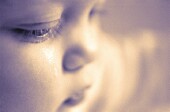
MONDAY, Nov. 28 (HealthDay News) — Boys with regressive autism have a larger head circumference and bigger brains than other children, a new study finds.
The differences in head size weren’t detected when the boys were newborns. However, at age 4 to 6 months, boys who went on to be diagnosed with regressive autism tended to have significantly larger heads than other kids, according to the study.
In regressive autism, children appear to develop normally or near normally and then markedly lose language and social skills between 18 and 24 months.
Researchers did not find larger heads and bigger brains among girls with regressive autism or children of either gender with early-onset autism, which emerges by about age 1 year.
Even though the symptoms of regressive autism don’t become obvious until children are approaching their second birthday, the findings suggest that whatever processes are occurring that lead to it start much earlier.
“At birth, you couldn’t detect a difference. But around 4 to 6 months of age, the kids who had regressive autism started deviating and their brains were significantly larger than the typically developing children,” said senior study author David Amaral, research director of the MIND Institute and a professor of psychiatry and behavioral sciences at University of California, Davis.
“Parents are often worried that what caused their child’s regression is something that happened to them just before the regression takes place. Our data suggests that may not be the case. It’s an ongoing process that starts when the children are younger and you only see it when the process has reached a critical stage,” Amaral explained.
The study appears online Nov. 28 in the Proceedings of the National Academy of Sciences.
Previous research has found that kids with autism tend to have accelerated brain growth early in life. This study drills down into greater detail about which kids experience that growth and when, said Dr. Joseph Horrigan, assistant vice president and head of medical research at Autism Speaks.
If the findings hold up in subsequent papers, head circumference could one day serve as an early warning sign of a child at risk of autism, he added.
“Head circumference is a relatively simple, noninvasive measurement that can be done during well-child visits and during clinic visits,” Horrigan said. “It could emerge as a potential screening tool during the first year of life, especially when working with a child of a high-risk family who already has a child with an autism spectrum disorder.”
In the study, researchers analyzed medical records that included head circumference measurements during checkups at pediatricians’ offices for 180 children from birth to 18 months. Head circumference, while not a direct measurement of brain size, is a proxy for brain size, according to the study. Children also had an MRI to measure brain size at age 3 years.
The study included 61 children with regressive autism, 53 kids with early-onset autism and 66 typically developing children.
Overall, the children with autism had a larger head circumference than those without. But that was mainly explained by the 10 percent of children — all boys, and all with regressive autism — who had very large heads, or heads larger than 97.5 percent of typically developing children, Amaral said.
When children with early-onset autism were separated out, their head and brain size was similar to that of typically developing kids.
In the study, about 53 percent of the children with autism had the regressive form, Amaral said.
The study does have limitations, noted Horrigan, including: the MRIs were done at only one point in time; the study included a relatively small number of participants; and the head circumference data were retrospective, or had been collected previously and then studied after the fact.
Still, he added, “these are intriguing preliminary findings that need to be replicated.”
Autism is a neurodevelopment disorder characterized by problems with social interaction, communication and restricted interests and behaviors. An estimated one in 110 U.S. children — many more boys than girls — has the disorder, according to the U.S. Centers for Disease Control and Prevention.
More information
The U.S. National Institute of Mental Health has more on autism.

